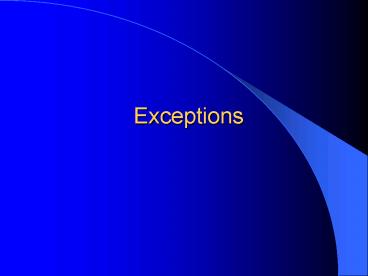Exceptions - PowerPoint PPT Presentation
1 / 18
Title:
Exceptions
Description:
Example: try { System.out.println(5/x); } catch(Exception e) ... f.println(...); // use like System.out. Make sure to close the file before exiting the program ... – PowerPoint PPT presentation
Number of Views:43
Avg rating:3.0/5.0
Title: Exceptions
1
Exceptions
2
Definition
- Exception something unexpected that can occur
in the execution of a program - e.g., divide by zero or attempt to open a file
that does not exist - Java provides a way to handle exceptions that are
thrown - the try-catch statement
3
Try-catch Statement
- Syntax
- try catch(Exception e) ...
- Example
- try
- System.out.println(5/x)
- catch(Exception e)
- System.out.println(/ by zero)
4
Breaking out of the try Block
- try
- statement1
- statement2 // if exception occurs here,
- // statement3 will be
skipped - statement3
- catch(Exception e)
- statement4 // executed after exception occurs
5
Why Use Try-catch ?
- Alternative if-statement
- will be complex and hard to read if there are
several exceptions - what if the exception occurs within a loop ?
(will need to worry about breaking out of the
loop) - Using try-catch is a more robust and structured
way of handling exceptions
6
Exception Classes
- Classes that extend the Exception class
- Allows the programmer to be more specific about
the exception - try catch (ArithmeticException e)
- Useful in a try-catch chain
7
Try-catch Chain
- try
- catch(SomeException se)
- catch(AnotherException ae)
- catch(YetAnotherException yae)
8
Built-in Exceptions(Unchecked RuntimeException
Subclasses)
9
Built-in Exceptions(Unchecked RuntimeException
Subclasses)
10
Files
11
File
- Unit of secondary storage
- Stores a sequence of bytes/characters
- Stream
- operations read from stream, write to stream
- Associated with a filename
- Often organized under a directory hierarchy
12
Input/Output Classesin Java
- I/O viewed as a stream of bytes
- parent classes InputStream, OutputStream
- As a stream of (Unicode) characters
- parent classes Reader, Writer
- Need to import java.io.
- An application employing files will use a
subclass of one of the above classes
13
Text Files
- To create a text file, use PrintStream
- f new PrintStream(new FileOutputStream(filename
.txt)) - To write to the text file use print methods
- f.println() // use like System.out
- Make sure to close the file before exiting the
program - f.close() // ensures contents are updated
14
Text Files, continued
- To read from text files, use either
DataInputStream or BufferedReader - f new DataInputStream( FileInputStream(filename
.txt)) - f new BufferedReader(new FileReader(filename.tx
t)) - Use read methods to read from file
- s f.readLine() // reads a string
15
Exceptions
- File operations throw exceptions so make sure
statements are enclosed in a try-catch statement - Exceptions thrown
- IOException
- Common (specific) exception FileNotFoundExceptio
n
16
Reading a File from the Web
- Use URL class from java.net
- To open ,
- wpage new URL(address)
- f new BufferedReader(new InputStreamReader(wpage
.openStream()))) - address is a String specifying the webpage
address (e.g., http//www.math.admu.edu.ph)
17
Binary Files
- Text files are often sufficient but sometimes we
want to store objects as they are (not their text
forms) in a file - Use ObjectOutputStream and ObjectInputStream
- operations writeObject() and readObject()
- common technique store objects in a Vector and
then save the Vector in the file
18
java.io. Summary
- There is a host of classes under this package
that serve a variety of purposes - Hints
- use javap java.io.classname to find out
available constructors and methods - you often need to use FileInputStream,
FileOutputStream, FileReader, and FileWriter to
associate a name to the file































